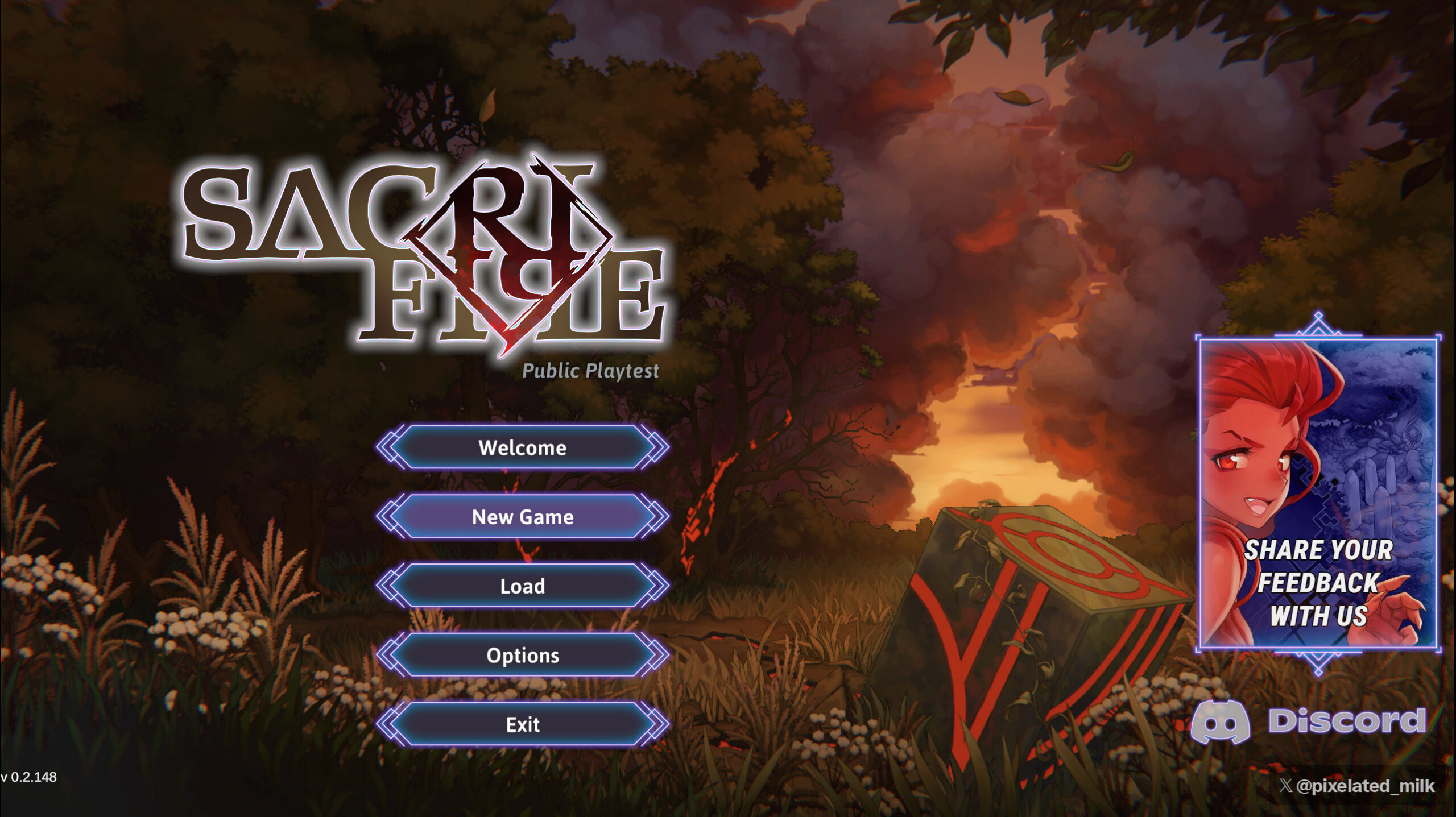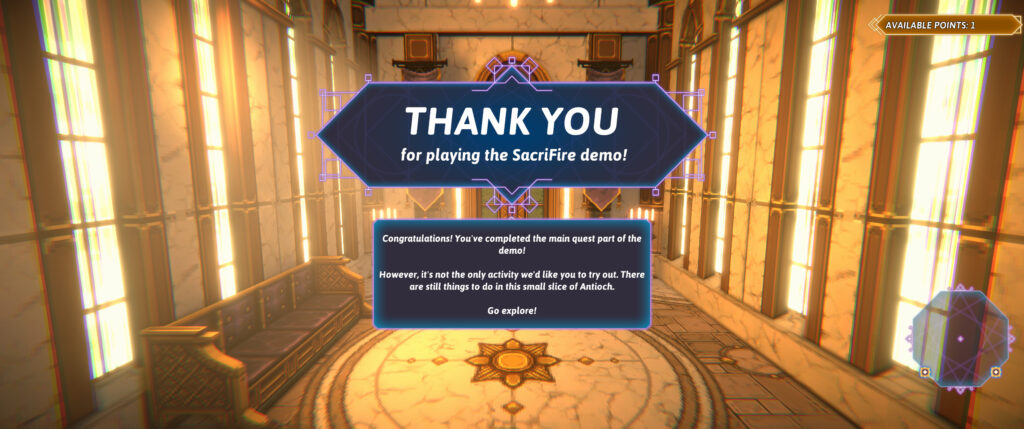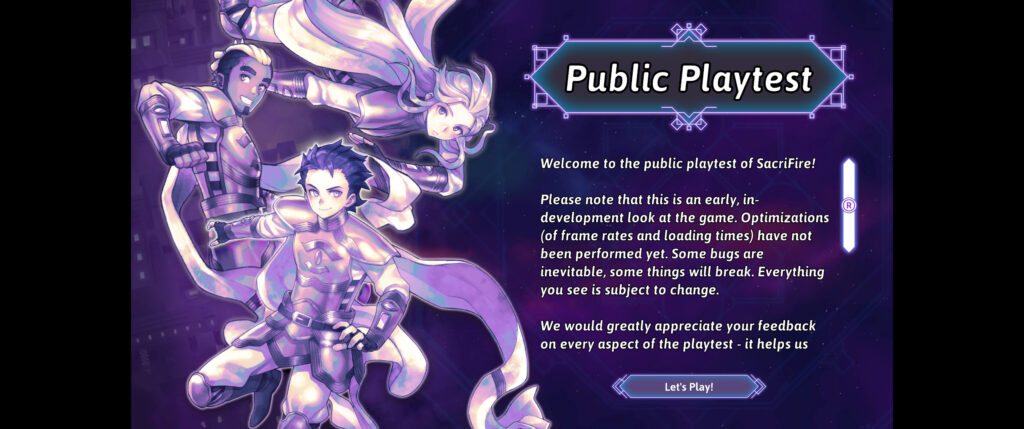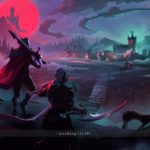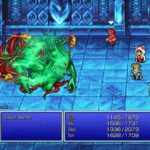Pixelated Milk’s new game in development, SacriFire, dropped their open playtest this weekend. This is the first time that even the game’s Kickstarter backers have been able to play the game, and… this game isn’t what I expected.
That’s not a bad thing, at all. It’s because in this golden age of JRPGs, I was playing the Final Fantasies, the Breaths of Fire, the turn-based choose-your-attack-from-a-menu kind of JRPGs. And I really, really liked them.
I didn’t end up playing too many of the Xenogears, Vagrant Story, Ao no Kiseke style game; games that were more 3D than sprite and more combo than menu. I’ve been trying over the past few years to make up for my deficiency here, or… I could just play SacriFire.

The Story
You play Ezekiel, a novitiate who is about to become a Bishop in his church. Ezekial lives in a city that is beset by monsters from below, demons from above, and heretics from within. Bishops are the front line troops tasked with keeping not only the city safe, but that Cube of Ultimate Evil that they keep safely in their cathedral, only bringing it out during the Ascension ceremony that mints new Bishops — Ezekiel, his best friend Zephania, and the mystery woman, Ava.
I don’t think it’s a spoiler to suggest that maybe something bad happens during the Ascension ceremony, and maybe it has something to do with the Spinning Cube of Ultimate Evil. And though the characters in the game have obviously never played a JRPG themselves, I have, and I have picked out a couple of people who probably aren’t who they claim to be. For one thing, Ezekiel has been so sheltered, he’s forgotten what a woman sounds like.
Gameplay
You play as Ezekiel. He is the only character you will ever be able to play; when other characters join you, they will be controlled by the computer. That means you only have to worry about gearing and leveling up the one character — Ezekiel. And it means that the story can hide the true motivations and actions of your temporary companions.
Play switches between 2D platforming exploration segments, and 3D battle arena segments. Meeting an enemy in the 2D world switches immediately to the battle arena, where you fight it out, generally you against several enemies. You can skip some fights by preemptively killing the mob in the 2D world, but you can only do this a certain number of times before you have to have a proper fight. Boss fights cannot be skipped, but the option is there for someone who doesn’t really want to spend a lot of time in random battles to just skip most of them.
Battle
There’s a bunch of different resources that need to be managed in battle. The Shield bar controls how much damage can be absorbed before Eze starts taking damage; the health bar tracks damage, the Zeal gauge fills as you perform actions and is used to power up special abilities, and the Action Point bar fills up by moving around, and powers both special abilities and normal attacks. The battle arena will spawn temporary orbs that refill a bar; which one depends on its color.
Like in Superhot, the enemies only move when you move. If you just put the controller down (while it can be played with a mouse and keyboard, Sacrifire was designed for controller), nothing will happen. Walk away, wait a week, come back, everything is in the same spot. Enemies telegraph their attacks using shaded target areas that gradually become brighter; they will attack when it becomes opaque.
Some mobs, and all the bosses and minibosses I met in the play test, have the occasional bullet hell attack that fills the arena with dozens of explosive orbs, usually moving in an obvious pattern. You can usually easily dodge this with the Roll move (which takes an action point and has a short cooldown), but when it’s two or three at once, or the boss drops orb spawners to take it to the next level, you’re probably going to take some damage.
In the play test chapter, I only had to restart one battle, and that was the last one, but I was close to game over a few times. Thankfully, you can save at any time, and there is usually a checkpoint near a boss fight that refills your health.
Character
Ezekial can unlock a wide range of abilities as he levels. Some will be more useful in certain fights than others. If you get into a fight and you just have the wrong abilities loaded, or think another path on the tree would be a better fit, you can (outside of battle) load the tech tree, get refunded for the abilities you don’t want, and buy the new ones. If you’re fighting a fire-based boss, you don’t want to go there with a fiery weapon. Really. I tried that. Didn’t go well.
Each ability can optionally swap in orbs that increase one of your statistics. You can choose any three abilities to be available in any given fight, as well as three or four consumables, like health pots, pots that grant you certain elemental affinities, and so on.
Gear seems to be less important in the game, in that I didn’t see any gear at all drop in this initial chapter.
Triple Triad
SacriFire comes with its own minigame that you can play with certain NPCs you come across. I think it’s a pet battle game, where you can earn more pets? I’m not sure, I couldn’t get it to work with the one person I came across that was willing to play. I may give it another shot. I don’t know if winning the game confers any advantages.
Music
The score is by famed Dark Souls composer, Motoi Sakuraba, who turns in tunes epic and atmospheric, as needed. It is really incredible stuff, and having Sakuraba on the team shows just how serious Pixelated Milk is about developing a game for the ages.
I did encounter some issues. One tutorial popup never seemed to want to go away. The graphical settings don’t seem functional. I guess that’s all I really noticed in my short time with the game. It took some time to figure out what was going on in some segments, but that’s probably by intention. I will say that the final battle in the sample chapter seemed heavily informed by battles I have seen in Final Fantasy XIV, and I think someone who hasn’t had that sort of experience might feel like they were missing something.
Most of the random battles were easily defeated by kiting all the mobs to one corner, using Cyclone to teleport away and leave them stuck there, followed by an AE fire ability. There were fights that required a little more finesse, but there is usually opportunity to dodge roll out of danger and run around for more AP to fire up a special ability.
So… how was it?
Fun. Easier than I expected, but still challenging enough to make it interesting. I am pretty sure I know who the mysterious thief whose capture drives this first chapter is, but then, I don’t think the developers are trying hard to hide it (or they are being especially devious by misleading those of us who are naturally suspicious). In these sorts of games, I always think about what the next plot twist could be… and that is part of the fun.
The game is very old school. Everything is pixel graphics, and the characters themselves are beautifully drawn sprites. Your 3D graphics card won’t be needed here. (Well, not for polygons, anyway). The Superhot-style combat is fun; it encourages you to get your enemies lined up juuuuuust right for your devastating combo, and really eases the stress that comes with real time battle games.
I backed the Kickstarter on the strength of its old school bona fides; I’m excited by what I’m seeing. Wishlist it on Steam!
